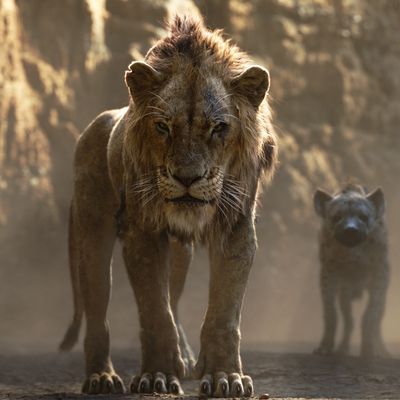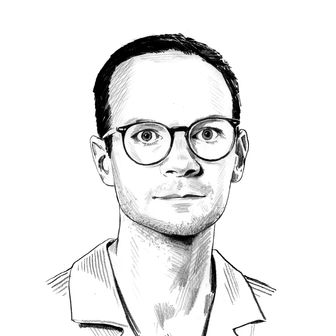
If there’s a moment where my vague, miasmatic disappointment in the uncanny, “realistic,” nature documentary-like universe of Disney’s CGI remake of The Lion King solidified into antipathy, it came between the parentheses on the film’s soundtrack, in the song titled “Be Prepared (2019).” In the original movie, Jeremy Irons plays Scar’s villain song like he’s leading a dance party in hell, with full-on sulfur and camp. By contrast, the 2019 version, performed by Chiwetel Ejiofor, is … fine? “Be Prepared” is a good song, you can’t really contest that, but the new version is slower and lacks the edge and bite of the original. It feels a bit like it’s being read off of cue cards, or as if the direction was to “make it evil, but you know, not evil and gay.” Disney thankfully does not attempt to make the photorealistic hyenas goose-step as they did in the original, but like the rest of the movie, the number feels safe, and therefore colorless. Scar, once a sneering and delightful villain, is now just boring, sad, and poorly groomed (someone, please, get that mane to a salon).
In interviews about playing Scar, Ejiofor has referred to the character in Shakespearean terms, which makes sense given that The Lion King is pretty much Hamlet and Scar is pretty much Claudius, who kills the king and wants to sleep with Hamlet’s mother, and whom Hamlet is supposed to kill in order to make everything right, at least within a monarchy. In Irons’s Scar, there was plenty of Shakespeare, but more strongly, he fell into a lineage of characters the new Lion King feels like it is purposefully trying to ignore: the coded-as-gay villain. Or, even more specifically, the gay cartoon Disney villain, a kind of cackling, campy fixture of Disney’s fairy tale-adjacent movies that many, many people (including, notably, the comedian James Adomain) have described in the past.
Gay villains, and especially the Disney kind that flourished in their animated movies in the late ’80s and early ’90s are, on the one hand, pretty obvious stereotypes. Scar is a preening lion with a limp paw who complains about being surrounded by idiots like he’s trying to establish some rules in his Fire Island timeshare. Jafar, in Aladdin, seems primarily interested in Jasmine for the drama of it all and the chance to purchase some new outfits in the process. Ursula never gets to the point of eating dog shit, but she was definitely inspired by the legendary drag queen Divine. These are fairy-tale stories, and in fairy-tale logic, the nice, heterosexual, symmetrical heroes are always expunging the other: the queer monsters that infect or upset the system, or even throw it into question.
Given how easy it is to set up a critique of so many Disney villains being coded as queer, it’s similarly easy to understand why the company would try to move away from that legacy. In its remake of Aladdin, Jafar was made scrappy and, uh, very masc. In The Lion King, Scar is now angry in an incel sort of way. Beauty and the Beast was careful to hand over its “exclusively gay moment” to a humanized version of LeFou. You have to go back to Cinderella (with Cate Blanchett giving a great performance as “Cate Blanchett as the stepmother”) or Maleficent to find a villain who’s having any fun — and really, Maleficent’s whole thing is that she’s not really a villain. In Animated Land, Moana did feature a delightful, David Bowie queer-ish crab, though in Frozen, the villain’s main problem is that he’s aggressively heterosexual. In these movies, there’s less of an association between queerness and evil, but also less queerness in general — and about as much camp as you get from people trying to dress up as “camp” at the Met Gala, which is to say, none at all.
It’s useful to think of Disney’s live-action remakes, alongside the fact that they’re immensely profitable, as large-scale restoration projects on the company’s own intellectual property. In addition to reintroducing audiences to stories they’ve seen before, Disney has made a concerted effort to at least superficially right the wrongs of the past movies. The Lion King, set in Africa, now has a black voice cast. Aladdin and Mulan both made efforts to be as authentic as they can be in depicting non-Western cultures. Like The Lion King, they still have white directors, plus ça change. If these updates are well-intentioned, and even that’s a maybe, they’re also strategic. I keep thinking about this one critique that argues that the Beauty and the Beast remake flails because it tries to correct every half-serious nitpick people online make about the original. Scar and Jafar’s newfound straightness feels of a kind with this trend, an attempt to paper over what people complain about in the originals without much examination. These are sloppy, colorful stories repainted by committee to be dull and without fault.
I’m not sure that sloppiness necessarily needs to be preserved, but I’m still sad to see it go, especially when gay villains disappear with it. Queer-by-coding villains are lazy tropes, but it’s silly to ignore the way those villains have also been embraced, especially by queer audiences. This kind of coding, which definitely didn’t originate with Disney movies, often shows many outsiders their place in a story, a place that’s edgy and interesting and radical in opposition to the people who are pretty and boring (and, as the witch in the deconstructed fairy tale that is Into the Woods bemoans, “nice”). The subversions and references that define the Disney villains of that animated Renaissance also often speak more directly to the lives of the people making them than anything in the rest of the movies, down to the poignancy of the Beast, the rare villain turned hero, wasting away in the era of AIDS. These weren’t necessarily messages the studio intended to send, but like most code, the message got across anyway: To watch those movies was to understand, you might feel like the villain, but hey, villains have more fun.
Back to the empty feeling of watching Scar in the new Lion King: In the theater, I felt angry that Scar wasn’t gay, that it wasn’t the same as when I was a kid. Not that I missed the exact line delivery and animation, necessarily, but I was disappointed to see whatever transgressive edge there was to the original sanded away. Imagine a version of Scar, or any villain, who has some actual (apologies) cattiness, and who’s allowed to be appealing in his deviousness. Or give me some new subversion, some idea of what the next iteration of villain might look like or speak to. Give me something compelling, something fabulous and outré, give me something that would shock even the original Scar. And please, dear god, give him a better haircut.





